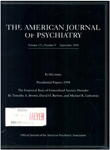Suicidal behavior and risk factors among runaway youths
Abstract
OBJECTIVE: The goal of this study was to describe suicide attempts and risk factors among runaway adolescents. METHOD: A structured interview format was used to assess suicidal behavior and suicide-related risk factors among a consecutive series of 576 predominantly black or Hispanic runaway adolescents at intake into four publicly funded runaway programs in New York City over a 2-year period. There were no significant differences in age, gender, race/ethnicity, education, or socioeconomic status among the adolescents at the four runaway program sites. RESULTS: Thirty-seven percent of the youths had previously attempted suicide, and 44% of the attempters had made an attempt within the previous month. Females were significantly more likely than males to have attempted suicide and to be depressed. Male runaways were far more likely to have attempted suicide than nonrunaway male adolescents described in previously published reports. Runaways with histories of attempting suicide were significantly more likely to be currently suicidal and depressed. CONCLUSIONS: This study indicates the need for systematic screening of runaway adolescents for suicidal ideation at residential shelters for youths.
Access content
To read the fulltext, please use one of the options below to sign in or purchase access.- Personal login
- Institutional Login
- Sign in via OpenAthens
- Register for access
-
Please login/register if you wish to pair your device and check access availability.
Not a subscriber?
PsychiatryOnline subscription options offer access to the DSM-5 library, books, journals, CME, and patient resources. This all-in-one virtual library provides psychiatrists and mental health professionals with key resources for diagnosis, treatment, research, and professional development.
Need more help? PsychiatryOnline Customer Service may be reached by emailing [email protected] or by calling 800-368-5777 (in the U.S.) or 703-907-7322 (outside the U.S.).



